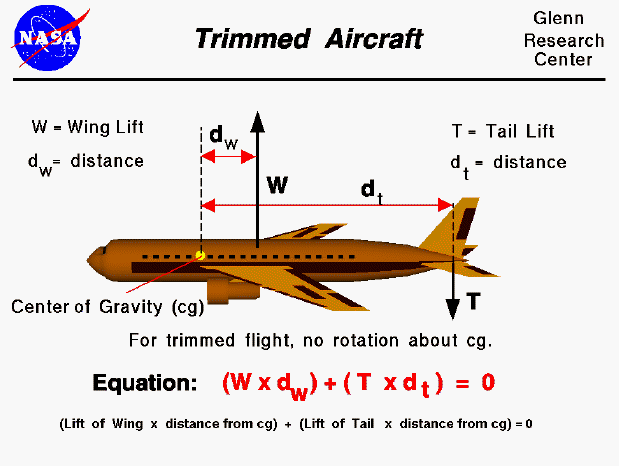

As described on the forces slide, the aircraft lift is the sum of the lift of all of the parts of the airplane and acts through the aircraft center of pressure. Each part of the aircraft has its own lift component and its own center of pressure. The major part of the lift comes from the wings, but the horizontal stabilizer and elevator also produce some lift which can be varied to maneuver the aircraft.
In flight, during maneuvers, the airplane rotates about its center of gravity (cg). But when the aircraft is not maneuvering, we want the rotation about the cg to be zero. When there is no rotation about the cg the aircraft is said to be trimmed.
On most aircraft, the center of gravity of the airplane is located near the center of pressure of the wing. It is desirable for aircraft stability to have the center of pressure aft of the center of gravity. Since the center of presure of the wing is aft of the center of gravity, its lift produces a counter-clockwise rotation about the cg. The center of pressure for the tail is always aft of the center of gravity, and a positive lift force from the tail also produces a counter-clockwise rotation about the cg. It is then not possible to balance the two rotations to produce no rotation about the cg. However, if the tail lift is negative it produces a clockwise rotation about the cg which can balance the wing rotation.
When a force acts at some distance from the center of gravity, it produces a torque, which is defined to be the product of the force times the distance. The torque is the "twisting force" that produces the rotation. To trim the aircraft it is necessary to balance the torques produced by the wing and the tail. The torque from the wing is equal to the lift of the wing (W) times the distance from the cg to the center of pressure of the wing (dw). The torque from the tail is equal to the lift of the tail (T) times the distance from the cg to the center of pressure of the tail (dt). In trimmed flight, these two torques are equal, remembering that the value of the lift of the tail must be negative. (This is the same kind of relation that exists on a teeter-totter.)
Go to...
byTom
Benson
Please send suggestions/corrections to: benson@grc.nasa.gov